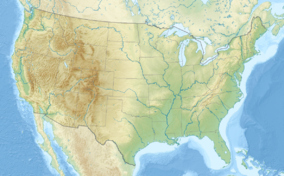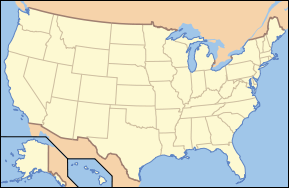- Grand Canyon National Park
-
Grand Canyon National Park 
View of the North Rim of the Grand CanyonLocation Coconino and Mohave counties, Arizona, United States Nearest city Fredonia, Arizona (North Rim)
Tusayan, Arizona (South Rim)Coordinates 36°03′19″N 112°07′19″W / 36.0552608°N 112.1218355°WCoordinates: 36°03′19″N 112°07′19″W / 36.0552608°N 112.1218355°W[1] Area 1,217,403 acres (492,666 ha)[2] Established February 26, 1919 Visitors 4,388,386 (in 2010)[3] Governing body National Park Service Type: Natural Criteria: vii, viii, ix, x Designated: 1979 (3rd session) Reference #: 75 State Party:  United States
United StatesRegion: Europe and North America Grand Canyon National Park is the United States' 15th oldest national park and is located in Arizona. Within the park lies the Grand Canyon, a gorge of the Colorado River, considered to be one of the Wonders of the World. The park covers 1,217,403 acres (1,902 sq mi; 4,927 km2) of unincorporated area in Coconino and Mohave counties.
Most visitors to the park come to the South Rim, arriving on Arizona State Route 64. The Highway enters the park through the South Entrance, near Tusayan, Arizona, and heads eastward, leaving the park through the East Entrance.[4] All park accommodations are operated by the Xanterra corporation. Park headquarters are at Grand Canyon Village, a short distance from the South Entrance, being also the location of the most popular viewpoints. Some thirty miles of the South Rim are accessible by road. A much smaller venue for tourists is found on the North Rim, accessed by Arizona State Route 67. There is no road connection between the two within Arizona except via the Navajo Bridge, near Page, Arizona, entailing a five-hour drive. Otherwise, the two rims of the Canyon are connected via Las Vegas, Nevada, and the Hoover Dam.[5]
The rest of the Grand Canyon is extremely rugged and remote, although many places are accessible by pack trail and backcountry roads.
Contents
History
Grand Canyon National Park became a national park in 1919. So famous is this landmark to modern Americans that it seems surprising that it took more than thirty years for it to become a national park. President Theodore Roosevelt visited the rim in 1903 and exclaimed: "The Grand Canyon fills me with awe. It is beyond comparison—beyond description; absolutely unparalleled throughout the wide world. ... Let this great wonder of nature remain as it now is. Do nothing to mar its grandeur, sublimity and loveliness. You cannot improve on it. But what you can do is to keep it for your children, your children's children, and all who come after you, as the one great sight which every American should see."
Despite Roosevelt's enthusiasm and his strong interest in preserving land for public use, the Grand Canyon was not immediately designated as a national park. The first bill to create Grand Canyon National Park was introduced in 1882 and again in 1883 and 1886 by Senator Benjamin Harrison. As President, Harrison established the Grand Canyon Forest Reserve in 1893. Theodore Roosevelt created the Grand Canyon Game Preserve by proclamation in 1906 and Grand Canyon National Monument in 1908. Senate bills to establish a national park were introduced and defeated in 1910 and 1911. The Grand Canyon National Park Act was finally signed by President Woodrow Wilson in 1919. The National Park Service, established in 1916, assumed administration of the park.
The creation of the park was an early success of the environmental conservation movement. Its National Park status may have helped thwart proposals to dam the Colorado River within its boundaries. (Lack of this fame may have enabled Glen Canyon Dam to be built upriver, flooding Glen Canyon and creating Lake Powell.) In 1975, the former Marble Canyon National Monument, which followed the Colorado River northeast from the Grand Canyon to Lee's Ferry, was made part of Grand Canyon National Park. In 1979, UNESCO declared it as a World Heritage Site.
The Grand Canyon, including its extensive system of tributary canyons, is valued for its combination of large size, depth, and the exposed layering of colorful rocks dating back to Precambrian times. It was created through the incision of the Colorado River and its tributaries after the Colorado Plateau was uplifted and the Colorado River system developed along its present path.
South Rim
The South Rim is easier to visit than the North Rim.[4] Access is available from I-40 from Las Vegas, California and the west coast and from Flagstaff, Arizona and points east, i.e., New Mexico or east of the Mississippi River. For areas to the north, U.S. 89 connects Utah and Colorado and the North Rim of the canyon to the south rim.[6]
Services
The Grand Canyon Village is located at the north end of U.S. 180, coming from Flagstaff. This is a full-service community, which includes lodging, fuel, food, souvenir, a hospital, churches and access to trails and guided walks and talks.[5]
Lodging
Lodging is available along the south rim at two locations. Campgrounds with tables and fireplaces are located in the village and at Desert View. Hotel-Motels include El Tovar Hotel, located in the village, and the Grand Canyon Lodge, located next to the campground.[5]
Activities
Activities vary from passive to strenuous and physical. For individuals with limitations (be it physical or time), there is the South Rim Drive (35 miles (56 km)). It is split into two segments. The West Rim is 8 miles (13 km) to Hermits' Rest. There are several overlooks along the way, including Mohave Point and Hopi Point, as well as the Powell Memorial.[5] The East Rim is 25 miles (40 km) out to Desert View. During the busy summer season, private vehicles are restricted along much of this route and a free shuttle gives everyone a chance to watch the scenery.Grand Canyon National Park.
For individuals interested in a leisurely stroll along the canyon rim, there is the Rim Trail, which follows the canyon for 4 miles (6.4 km) from the Yavapai Museum east to Maricopa Point. The Canyon Rim Nature Trail is only 1.5 miles (2.4 km) and leads from the El Tovar Hotel to the Park Visitor center.
Grand Canyon Association
Main article: Grand Canyon AssociationThe Grand Canyon Association (GCA) is the National Park Service's official non-profit partner raising private funds to benefit Grand Canyon National Park. It operates retail shops and visitor centers within the park, and provides educational opportunities about the natural and cultural history of the region. It was founded by naturalist Edwin D. McKee in February 1932 as the Grand Canyon Natural History Association.
In October 1994, the association's board of directors approved changing the name of the association from Grand Canyon Natural History Association to Grand Canyon Association, in part to emphasize an expanding list of services, books, and products focusing on cultural history, thus not always fitting the bill of "natural history."
In 2010, Grand Canyon National Park was honored with its own coin under the America the Beautiful Quarters program.[7]
Books
GCA publishes 3 to 5 books on average annually. Topics of their books include original research on the Grand Canyon, scientific monographs, American Indian history, and guidebooks.
In association with Grand Canyon National Park, GCA co-publishes the park's newspaper, The Guide, with translations in many languages, including Spanish, Japanese, Chinese, French, German, Korean, and Italian.
Gallery
-
A rockfall as seen from the North Rim.
Sister Park
- Yuntai Mountain (Henan)
See also
References
- ^ "Grand Canyon National Park Visitor Center". Geographic Names Information System, U.S. Geological Survey. http://geonames.usgs.gov/pls/gnispublic/f?p=gnispq:3:::NO::P3_FID:20784. Retrieved 2011-08-14.
- ^ "Listing of acreage as of 12/31/2010". Public Use Statistic Office, National Park Service. http://www.nature.nps.gov/stats/Acreage/acrebypark10cy.pdf. Retrieved 2011-06-05.
- ^ "Five Year Annual Recreation Visits Report". Public Use Statistic Office, National Park Service. http://www.nature.nps.gov/stats/viewReport.cfm?selectedReport=SystemComparisonReport.cfm. Retrieved 2011-06-05.
- ^ a b Rand McNally; National Park Buide; Michael Frome; Rand McNally & Company, Chicago; 1970; pg 47
- ^ a b c d South Rim, Grand Canyon National Park, Arizona; National Park Service; US Government Printing Office; 1972
- ^ Rand McNally, Road Atlas, United States, Canada, Mexico; 2010
- ^ "Grand Canyon Coin Introduced". United States Mint. 2010. http://www.americathebeautifulquarters.gov/coins/2010/grand-canyon.
External links
 External images
External images
Public domain images from the National Park Service. - Official website
- Grand Canyon National Park at the Open Directory Project
- Interactive Google Maps Hiking Guide
- Grand Canyon Virtual Tour-360 fullscreen panoramas
- Cell Phone Audio Tours of the Grand Canyon 1-928-225-2907
National parks of the United States Acadia • American Samoa • Arches • Badlands • Big Bend • Biscayne • Black Canyon of the Gunnison • Bryce Canyon • Canyonlands • Capitol Reef • Carlsbad Caverns • Channel Islands • Congaree • Crater Lake • Cuyahoga Valley • Death Valley • Denali • Dry Tortugas • Everglades • Gates of the Arctic • Glacier • Glacier Bay • Grand Canyon • Grand Teton • Great Basin • Great Sand Dunes • Great Smoky Mountains • Guadalupe Mountains • Haleakalā • Hawaiʻi Volcanoes • Hot Springs • Isle Royale • Joshua Tree • Katmai • Kenai Fjords • Kings Canyon • Kobuk Valley • Lake Clark • Lassen Volcanic • Mammoth Cave • Mesa Verde • Mount Rainier • North Cascades • Olympic • Petrified Forest • Redwood • Rocky Mountain • Saguaro • Sequoia • Shenandoah • Theodore Roosevelt • Virgin Islands • Voyageurs • Wind Cave • Wrangell-St. Elias • Yellowstone • Yosemite • ZionWorld Heritage Sites in the United States Northeast Midwest South West Carlsbad Caverns · Chaco Culture · Grand Canyon · Hawaii Volcanoes · Kluane-Wrangell-St. Elias-Glacier Bay-Tatshenshini-Alsek1 · Mesa Verde · Olympic National Park · Pueblo de Taos · Papahānaumokuākea · Redwood · Waterton Glacier International Peace Park1 · Yellowstone · Yosemite
Territories 1 Shared with CanadaProtected Areas of Arizona Federal Gila Box Riparian · Las Cienegas · San Pedro RiparianArizona National Scenic Trail · Juan Bautista de Anza National Historic Trail · Old Spanish National Historic TrailBill Williams River · Buenos Aires · Cabeza Prieta · Cibola · Havasu · Imperial · Kofa · Leslie Canyon · San BernardinoOtherCoronado National Memorial · Elden Pueblo · Glen Canyon National Recreation Area · Lake Mead National Recreation Area · Palatki Heritage Site · V-Bar-V Heritage SiteState Western RegionAlamo Lake · Buckskin Mountain · Cattail Cove · Lake Havasu · River Island · Yuma Quartermaster Depot · Yuma Territorial PrisonNorthern RegionDead Horse Ranch · Fort Verde · Homolovi · Jerome · Red Rock · Riordan Mansion · Slide Rock · Verde River GreenwayEastern RegionBoyce Thompson Arboretum · Catalina · Fool Hollow Lake · Lost Dutchman · Lyman Lake · McFarland · Oracle · Tonto Natural BridgeSouthern RegionKartchner Caverns · Patagonia Lake · Picacho Peak · Roper Lake · San Rafael · Sonoita Creek · Tombstone Courthouse · Tubac PresidioMunicipal Other See List of National Natural Landmarks in ArizonaCategories:- IUCN Category II
- Grand Canyon
- Grand Canyon National Park
- Parks in Coconino County, Arizona
- Parks in Mohave County, Arizona
- Protected areas established in 1919
- Protected areas on the Colorado River
- World Heritage Sites in the United States
Wikimedia Foundation. 2010.







